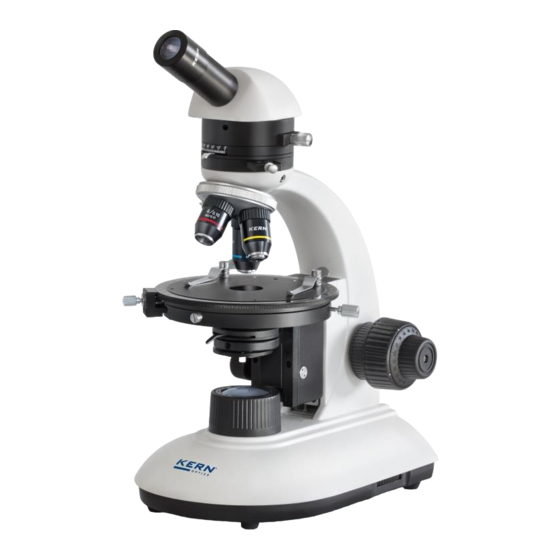
Table of Contents
Advertisement
Quick Links
Advertisement
Table of Contents

Summary of Contents for KERN Optics OPE-1
- Page 1 KERN & Sohn GmbH Ziegelei 1 Tel: +49-[0]7433- 9933-0 D-72336 Balingen Fax: +49-[0]7433-9933-149 E-Mail: info@kern-sohn.com Internet: www.kern-sohn.com User instructions Polarisation microscope KERN OPE-1 OPE 118 Version 1.0 01/2016 OPE-1-BA-e-1610...
-
Page 3: Table Of Contents
Adjusting the magnification ....................14 Adjusting the illumination ..................... 15 Adjusting the polarisation unit ..................... 16 Changing the bulb ..............17 Changing the fuse ..............17 Trouble shooting ................ 18 Service ..................20 Disposal ..................20 Further information ..............20 OPE-1-BA-e-1610... -
Page 4: Before Use
Suitable replacement fuses are included with the delivery. When carrying out any procedures whereby you come into contact with the electrical system of the device, such as, for example, changing the bulb or fuse, only carry out these procedures when the power is disconnected. OPE-1-BA-e-1610... -
Page 5: Storage
The best way to store accessories which consist of optical elements, such as, for example, eyepieces and objectives, is in a dry box with desiccant. OPE-1-BA-e-1610... -
Page 6: Maintenance And Cleaning
Special cleaner for optical lenses Special optical cleaning cloths Bellows Brush When handled correctly and checked regularly, the microscope should give many years of efficient service. Should repairs still be necessary, please contact your KERN dealer or our Technical Department. OPE-1-BA-e-1610... -
Page 7: Nomenclature
2 Nomenclature OPE-1-BA-e-1610... -
Page 8: Technical Data / Features
WF 10x / Ø 18 mm 6V / 20W Halogen (Transmitted) 4x/10x/40x Product dimensions: 360x200x400 mm Packaging dimensions: 440x340x240 mm Net weight: 5,5 kg Gross weight: 6 kg Input voltage: AC 100-240V, 50-60Hz Output voltage: DC 1,2-6V Fuse: 2A 5x20mm OPE-1-BA-e-1610... - Page 9 OPE-1-BA-e-1610...
-
Page 10: Assembly
The eyepiece is simply placed onto the tube connectors, when the protective cover is removed before. There is no possibility of fixating the eyepiece. You should always make sure that you do not touch the lenses with your bare fingers and that no dust enters the apertures. OPE-1-BA-e-1610... -
Page 11: Colour Filter
4.4 Colour filter Standardly the microscopes of the OPE-1 series are equipped with a blue colour filter. This filter is firmly connected to a holding ring an you can simply put it onto the housing of the field lens in case of usage. -
Page 12: Pre-) Focussing
Important: In order to avoid damaging to the focussing system, the left and right adjustment wheels for the coarse and fine adjustment knob must never be rotated at the same time in opposite directions. OPE-1-BA-e-1610... -
Page 13: Centre-Adjusting The Stage
For getting ideal results the centre of the rotation axis of the table must be aligned to the centre of the optical beam path. The microscopes of the OPE-1 series are correctly set at factory. However we recommend to regularly check before the first use and every now and then if the table is centre-adjusted. - Page 14 9. Operate the centring screws, so that the centre of the reticule and the centre of the eyepiece scale are aligning to each other again. 10. Repeat steps 6 - 9. OPE-1-BA-e-1610...
-
Page 15: Adjusting The Magnification
If you have focussed the object to be observed for a specific magnification, then if you select the objective with the next greatest magnification, then the object will be slightly out of focus. Use the fine adjustment knob to make a slight adjustment and restore the focus. OPE-1-BA-e-1610... -
Page 16: Adjusting The Illumination
If the eyepiece should be removed, for checking, then please make sure that no dirt or dust falls into the tube. 3. The brightness is always controlled by the bulb brightness (using the dimmer) and not by the aperture diaphragm. OPE-1-BA-e-1610... -
Page 17: Adjusting The Polarisation Unit
Each of the two other apertures contains one Lambda filter (¼ λ and λ). They can be used in order to adjust the interference colours, which are the result of polarised light colliding with the sample. OPE-1-BA-e-1610... -
Page 18: Changing The Bulb
When doing this, it is helpful to use a screwdriver or similar tool. The defective fuse can be removed from its housing and be replaced with a new one. After that, you just need to insert the fuse housing back into the insertion point below the mains power supply socket. OPE-1-BA-e-1610... -
Page 19: Trouble Shooting
Dioptre setting has not been carried out correctly The field of view of one eye does not Different eyepieces are used for the match that of the other eye righthand and lefthand side The eyes are not used to using a microscope OPE-1-BA-e-1610... - Page 20 The stage moves down on its own The rotational resistance brake is not tight The fine adjustment knob moves on its enough When you move the table, the image The stage was not correctly fitted becomes blurred OPE-1-BA-e-1610...
-
Page 21: Service
The descriptions and illustrations in this user manual are subject to change without notice. Further developments on the device may lead to these changes. All language versions contain a non-binding translation. The original German document is the binding version. OPE-1-BA-e-1610...














Need help?
Do you have a question about the OPE-1 and is the answer not in the manual?
Questions and answers